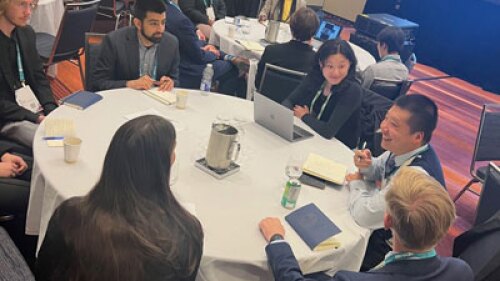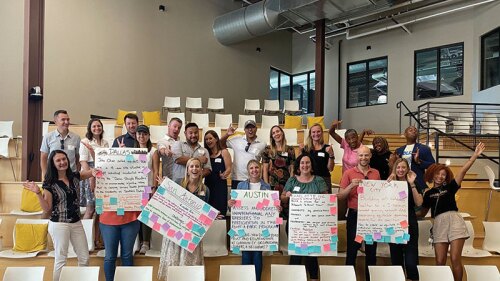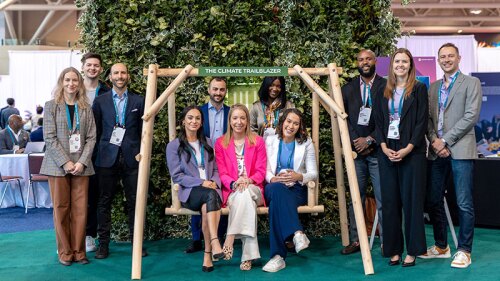Roughly the size of New Jersey, Riverside County, California, covers 7,200 square miles (18,600 sq km) and is the fourth-most-populous county in the state. On a map, it appears as a near-perfect rectangle that stretches from high desert with Joshua trees and sagebrush in the east, through the resort towns of the Coachella Valley, to the rapidly urbanizing west, which includes some of the fastest-growing U.S. Census tracts in the state.
Over the past decade, the cities of Temecula, Murrieta, Moreno Valley, and Lake Elsinore have continued to absorb newcomers as commuters from Orange and Los Angeles counties seek decent schools and affordable places to live. Also known as southern California’s Inland Empire, these areas happen to be among the most drought-stricken regions in California, which recently imposed mandatory water restrictions on homes and businesses.
The combination of explosive growth and natural resources stretched thin might intimidate even the most experienced public servant—unless that person is ULI member Rick Bishop. The executive director of the Western Riverside Council of Governments, a coalition of local government leaders from 17 of the county’s 18 municipalities, Bishop is unfazed, even optimistic, about the complex challenges that lie ahead for western Riverside. In his view, the drought has given residents an opportunity to reevaluate their priorities and do the right thing.
“One of the interesting things about the drought is that people are moving beyond the belief that we’ll get a good hard rainstorm and everything will be fine,” Bishop says. “There’s an increasing sense that we need to plan for future growth in which drought conditions are the norm, and not the extreme. More and more, people are getting rid of their lawns and cutting back on their watering. There’s sort of this sense of pride at having a brown lawn instead of a green one. In many ways, the drought has become a rallying moment for the state.”
The Western Riverside Council of Governments, known as “WRCOG,” is a unique agency in that participation in it is entirely voluntary. Its member cities have chosen to belong since the issues they face—air quality, water quality and conservation, energy conservation, housing, transportation planning—transcend jurisdictional lines.
“Our overall approach is that there’s strength in numbers,” Bishop says. “There’s also cost efficiency in doing things as a region rather than doing things 18 times over on an individual basis. We try to provide that regional perspective and try to act like political boundaries don’t exist.”
Economy and Environment Are Not Mutually Exclusive
As executive director, Bishop faces a tough balancing act. He must educate his board on best practices and trends without advocating too strongly for one side or another. He must implement programs relating to water and energy conservation, fossil-fuel alternatives, and strategies to reduce carbon emissions in an area notorious for sprawling suburbs, manicured lawns, and a car-dominated culture.
In Bishop’s opinion, finding the right language is key to opening minds. Terms like sustainability and even climate change can still alienate those who feel more burdened by environmental laws than empowered by them.
“As planners, we have to acknowledge that some of our jargon hurts more than helps us,” he says. “Those kinds of buzzwords are still viewed suspiciously by some. One of our main goals is to convey that helping the economy and helping the environment don’t have to be seen as mutually exclusive. A strong economy should be based upon strong environmental protections; the two can really work together.”
ULI Orange County/Inland Empire Chair Randal Jackson, president and principal of PlaceWorks, admires Bishop’s ability to build consensus around sensitive issues, crediting him with creative approaches to educating the public. He tells the story of the two teaming up to produce a short film about sustainable growth in Riverside County, which Bishop got local movie theaters to show as a trailer before the main feature.
“I’m impressed by him as an individual not to just do the status quo, but to step out and bring people together,” Jackson says. “He’s always so optimistic. I’ve never seen him be down. You may not always agree with what he’s saying, but you will stop and listen to him.” His commitment to and leadership at WRCOG so impressed ULI Orange County’s Sustainable Communities Initiative Council that it awarded him a Best of the Best Award this past April.
The Home Energy Renovation Opportunity (HERO) program illustrates Bishop’s belief that environmentally sound goals can lead to further prosperity. A financing program for making energy efficiency upgrades to residential and commercial properties, the HERO program served to jump-start Riverside County’s economy after the Great Recession. The crash of the housing market, which is heavily reliant on homebuilding and construction, caused these industries to contract and lay off workers. The HERO program put them back to work as contractors retrofitting homes and offices.
Something that had started out as a job-creating tool soon turned into a cost-saving benefit to homeowners, lowering their utility bills and increasing the comfort and value of their homes, Bishop says. In addition, when Riverside County was notified by Southern California Edison that the San Onofre Nuclear Plant was being decommissioned, the need to conserve energy through programs like HERO acquired new urgency. “One of the best ways to ensure future energy supply is to conserve the energy that we already have,” he adds.
The Story of Growth Has Yet to Be Written
At a recent WRCOG meeting, Bishop’s board agreed that economic development of the region had to be driven by the quest to improve the quality of life, rather than by streamlining permitting processes, reducing fees, or employing a similarly piecemeal approach.
“Our board recognized that economic development can only occur when you create a community where people want to live and work,” he says. By focusing on expanding housing and transportation choices, the quality of education, and energy security and ensuring reliable sources of water, WRCOG has opted for a more holistic approach to creating prosperity.
As more of western Riverside’s cities transition from single-use subdivisions to mixed-use communities, more opportunities will emerge to create dense, walkable communities with a variety of housing options, opportunities to stay active through bike and walking trails, and access to transit. Until this point, the focus has been on building or expanding roads, but Bishop wonders whether driving is going to be the primary mode of transportation 20 years from now. “Our real goal should be: how do we keep people out of a 3,000-pound vehicle to drive a mile down the road to pick up a one-pound loaf of bread?”
It is a good question since western Riverside’s population is expected to increase by 1 million new residents by 2035, according to WRCOG. Once again, Bishop strikes an optimistic tone: “There’s a real sense that with those kinds of projections, the western Riverside story has yet to be written.”




